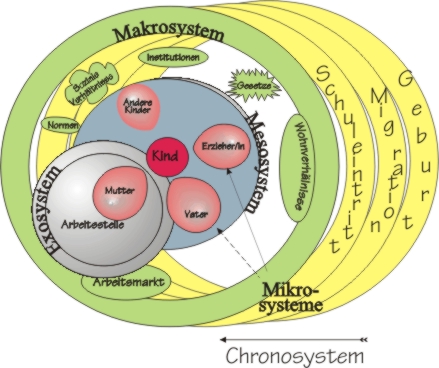Bronfenbrenner's ecosystem approach
Using the ecosystem approach , the psychologist Urie Bronfenbrenner created a system of influencing factors in human development in the late 1960s . He was significantly influenced by Kurt Lewin and his concept of locomotion.
description
Ecosystem means the entire material and social environment of a person.
- Ecology: biological interrelationship between organisms and their natural environment
- System: the entirety of elements that are related to or connected to one another and interact with one another
Bronfenbrenner divides the entire human ecosystem into the following system levels:
- The microsystem (red in the graphic) consists of a multitude of activities, roles and interpersonal relationships that a person experiences in one area of life. For example, the relationship with family, school, the workplace, etc. At this level of personal relationships, for example, small children, in interaction with their caregivers, help shape their own developmental conditions.
- A mesosystem (blue) is about the individual microsystems, how they are connected to one another and how they influence one another. An example of a mesosystemic interaction is the interplay between daycare and parents.
- An exosystem (gray) is a network of relationships to which the person does not belong directly, so that they have only limited or no influence on its design. Nevertheless, the exosystems sometimes have a considerable influence, since caregivers of the person belong to it. One such exosystem is, for example, the workplace of the mother of a child. If she does shift work, for example, there is increasingly a lack of mother-child interaction. The low level of influence with a simultaneously high impact is illustrated by the example of the interaction between teachers and parents when choosing a school at the end of primary school . The living environment or mass media are also important influencing factors for a child.
- The macro system (green) is the totality of all relationships in a society, including norms , values , conventions , traditions , codified and unwritten laws , regulations and ideologies .
- Chronosystems (yellow) encompass the temporal dimension of development, e.g. B. the distinctive points in time in development and their biographical sequence. Bronfenbrenner differentiates between “normative” chronological systems (such as starting school or starting work) and “non-normative” (such as serious illness of relatives or winning the lottery).
background
For Urie Bronfenbrenner, the interplay between systems and the transition of people from one system to another are in the foreground of his considerations. With this approach, he examines different framework conditions in which human (primarily child) development takes place. Among other things, he works out that it is important for development that the various systems of a person are compatible with one another; that experiences and behaviors that a person has learned in one system can also be used in other systems and that people should also have an influence on the design of the various systems in which they participate.
criticism
Critics object to this approach that it only argues formally and largely disregards social power mechanisms.
Analysis of empirical phenomena
In addition, Bronfenbrenner's approach was also used to record empirical phenomena. The ecosystem approach in combination with an empirical method enables a very specific approach that enables specific research questions and findings.
literature
- A. Epp: From school to vocational training. Social constructions by teachers about unfavorable factors in the educational biography of students. Leverkusen u. a. 2017, ISBN 978-3-8474-2128-3 .
- A. Epp: The ecosystem development model as a theoretical sensitization and observation grid for empirical phenomena. In FQS, Vol 19, No. 1st, 2018.
- G. Russell & N. Kelly: Research as Interacting Dialogic Processes: Implications for Reflexivity. In: FQS, Vol. 3, No. 3, 2002.
- Urie Bronfenbrenner: The ecology of human development. Natural and Planned Experiments . Klett-Cotta, 1981, ISBN 3-12-930620-X .
- Urie Bronfenbrenner: Recent Advances in Research on the Ecology of Human Development . In: R.-K. Silbereisen, K. Eyferth, G. Rudinger: Development as Action in Context - Problem Behavior and Normal Youth Development . Springer, Berlin 1986, pp. 287-310.
- Urie Bronfenbrenner, Ann Crouter: The evolution of environmental models in developmental research . In: P.-H. Mussen: Handbook of Child Psychology, Volume I: History, Theory, and Methods . 4th Edition, John Wiley & Sons, New York 1983, pp. 357-414.
